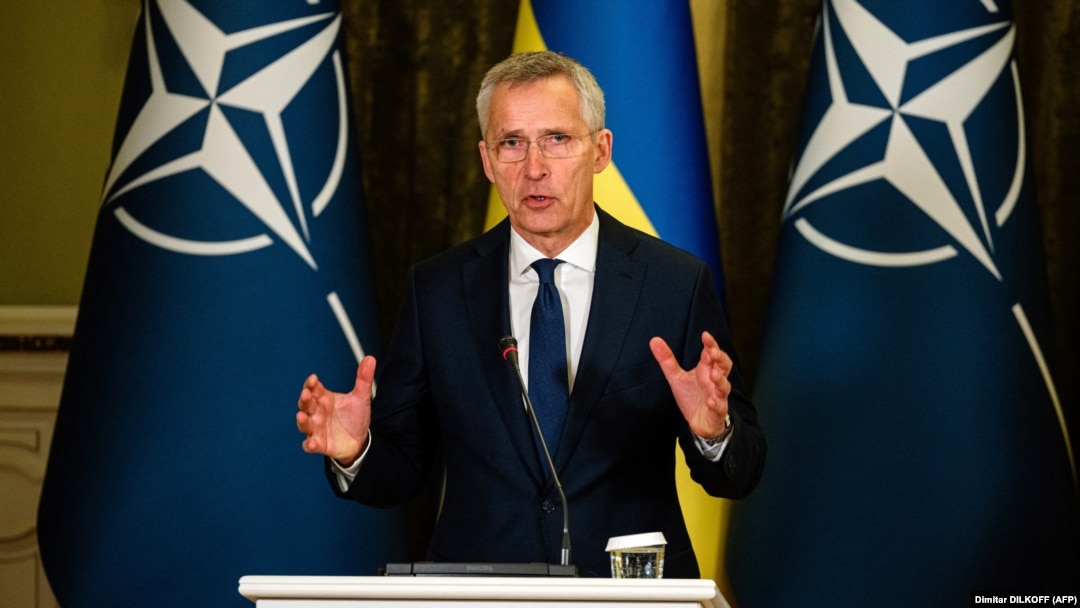Military aid from allies and partners has substantially improved Ukraine's prospects to liberate territories occupied by Russia since the start of its unprovoked invasion, NATO chief Jens Stoltenberg said on April 27, as Kyiv reported that heavy fighting was under way for control of Bakhmut, the eastern city that has been at the epicenter of Russia's offensive.
Stoltenberg, speaking to reporters at NATO headquarters in Brussels, said that "more than 98 percent" of the combat vehicles pledged by the allies have already been delivered.
"That means over 1,550 armored vehicles, 230 tanks, and other equipment, including vast amounts of ammunition," he said at a news conference with Luxembourg Prime Minister Xavier Bettel.
"In total, we have trained and equipped more than nine new Ukrainian armored brigades. This will put Ukraine in the strong position to continue to retake occupied territory," Stoltenberg said.
It wasn't immediately clear how many troops were involved in the training, but in Western militaries, a brigade has between 3,000-5,000 soldiers.
The alliance chief, however, cautioned that "we should never underestimate Russia" despite the "unprecedented" military support that Ukraine received from its partners and allies.
Moscow was "willing to send in thousands of troops with very high casualty rates," he said.
Stoltenberg's statements came amid reports that Kyiv was preparing a long-anticipated counteroffensive that could be launched once the weather warmed and the terrain improved.
Yevgeny Prigozhin, the Kremlin-connected businessman who controls the notorious Wagner mercenary group that is spearheading Russia's assault on Bakhmut, said on April 26 that Kyiv would most likely launch its counteroffensive, which he called "inevitable," at the start of next month.
The Ukrainian side has not commented on Prigozhin's statement.
Russian forces meanwhile continued to strike residential areas in Ukraine, local officials said.
Russians shelled a residential quarter of the southern city of Kherson, killing one person, the head of the regional military administration, Oleksandr Prokudin, said on April 27.
Overnight, Russia struck the southern Ukrainian city of Mykolayiv with surface-to-air missiles, killing at least one civilian and wounding several others.
Russian troops targeted Mykolayiv with four S-300 missiles, killing one person, the head of regional military administration, Vitaly Kim, said on Telegram, adding that at least one high-rise building and two private residential buildings were hit in the city.
"High-precision weapons were aimed at private houses, a historic building, and a high-rise building [in Mykolayiv]," President Volodymyr Zelenskiy said on April 27.
The mayor of Mykolayiv, Oleksandr Syenkevych, said part of the city was left without electricity following the strike.
Mykolayiv region and its capital have been frequently targeted by Russian shelling over the past months.
Since the beginning of its full-scale invasion of Ukraine, Russia has denied targeting civilians, despite abundant evidence to the contrary.
In Donetsk region, heavy fighting continued on the Bakhmut-Adviyivka-Maryinka front line, Ukraine's General Staff said in its daily update on April 27.
Bakhmut From The Air Reveals Devastation As Russia Pounds Ukrainian City Into Dust
"The attacker is concentrating its main efforts on offensive operations in Bakhmut, Avdiyivka, and Maryinka, where the Defense Forces of Ukraine repelled 54 attacks during the past 24 hours. The fiercest battles continue in Bakhmut and Maryinka," the military reported.
Serhiy Cherevatiy, the spokesman for the eastern military command, told Ukrainian television on April 26 that Russian forces were razing Bakhmut to the ground.
"The Russians are destroying buildings in Bakhmut to prevent our soldiers from using them as fortifications," Cherevatiy said.


